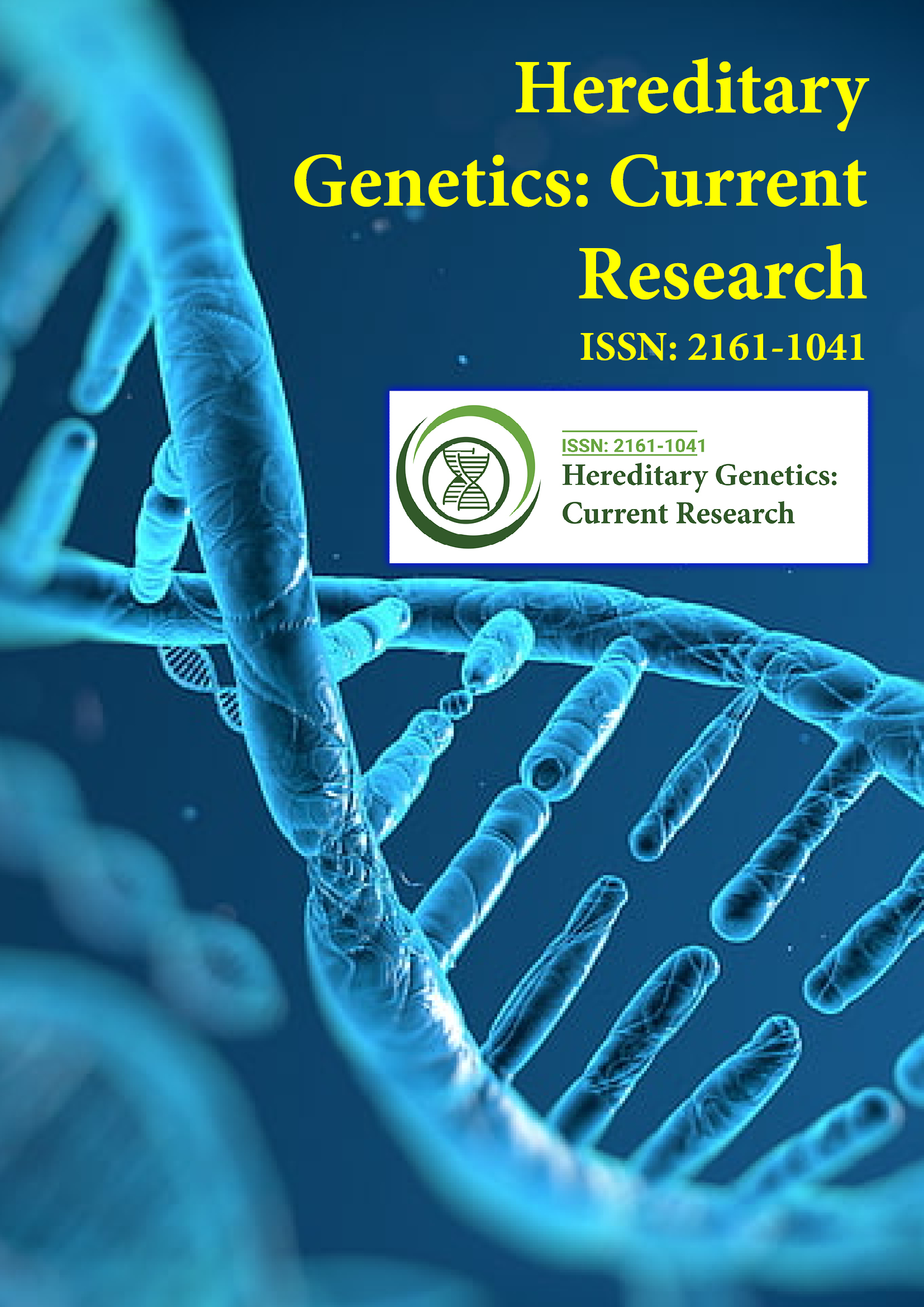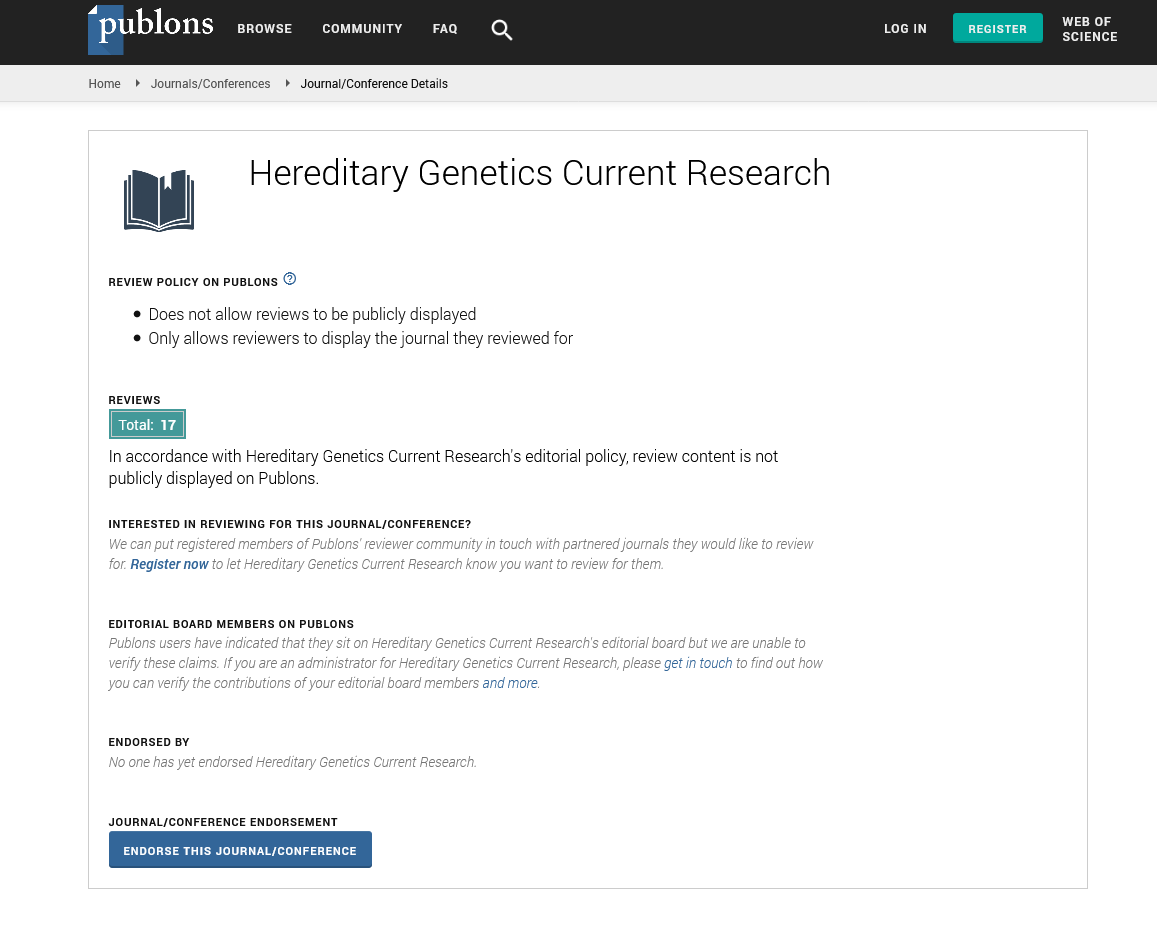Indexed In
- Open J Gate
- Genamics JournalSeek
- CiteFactor
- RefSeek
- Hamdard University
- EBSCO A-Z
- NSD - Norwegian Centre for Research Data
- OCLC- WorldCat
- Publons
- Geneva Foundation for Medical Education and Research
- Euro Pub
- Google Scholar
Useful Links
Share This Page
Journal Flyer

Open Access Journals
- Agri and Aquaculture
- Biochemistry
- Bioinformatics & Systems Biology
- Business & Management
- Chemistry
- Clinical Sciences
- Engineering
- Food & Nutrition
- General Science
- Genetics & Molecular Biology
- Immunology & Microbiology
- Medical Sciences
- Neuroscience & Psychology
- Nursing & Health Care
- Pharmaceutical Sciences
Commentary - (2024) Volume 13, Issue 4
The Epigenetic and Polygenic Facets of Hereditary Spherocytosis
Matthew Banks*Received: 29-Nov-2024, Manuscript No. HGCR-24-28202; Editor assigned: 02-Dec-2024, Pre QC No. HGCR-24-28202 (PQ); Reviewed: 16-Dec-2024, QC No. HGCR-24-28202; Revised: 23-Dec-2024, Manuscript No. HGCR-24-28202 (R); Published: 30-Dec-2024, DOI: 10.35248/2161-1041.24.13.293
Description
Hereditary Spherocytosis (HS) is a well-characterized hemolytic anemia that arises from defects in Red Blood Cell (RBC) membrane proteins, leading to reduced cell deformability and premature hemolysis. For decades, the genetic foundations of HS have been defined by mutations in a handful of key genes such as ANK1, SPTA1, SPTB, EPB42 and SLC4A1. These genes encode proteins that maintain the stability and elasticity of the RBC membrane and their mutations typically follow Mendelian inheritance patterns, either autosomal dominant or recessive.
However, advancements in genomics and molecular biology have revealed that the story of HS genetics is far from complete. Noncanonical genetic factors-mechanisms and pathways that deviate from traditional Mendelian genetics-are emerging as significant contributors to the complexity of this disorder. These include polygenic influences, modifier genes, epigenetic changes, mitochondrial DNA variants and non-coding RNA molecules. Such findings highlight the need to revisit our understanding of HS, not as a monogenic disorder but as a condition influenced by a complex exchange of genetic and regulatory elements. This change in perspective creates the path for more accurate diagnostics, personalized treatment approaches and deeper insights into the biology of red blood cells.
The classic genes implicated in HS remain central to its diagnosis, but there are examples where patients with clinical HS do not exhibit mutations in these canonical genes. This has led researchers to describe polygenic and modifier contributions. For example, minor variations in genes involved in oxidative stress regulation, iron metabolism, or erythropoiesis may exacerbate the phenotypic severity of HS. Studies in high-income countries such as Germany and the United States have highlighted the role of modifier genes, which can influence the expression of primary mutations. For example, polymorphisms in genes regulating red blood cell turnover may modulate anemia severity in HS patients. These findings highlight the importance of looking beyond primary genetic mutations to fully understand the variability in clinical presentations.
Research from institutions such as the Karolinska Institute in Sweden and the Broad Institute in the United States of America has provided evidence for epigenetic regulation in red blood cell disorders. For example, differential methylation patterns in genes associated with erythropoiesis may contribute to the heterogeneity observed in HS. These insights have significant implications for therapy, as epigenetic changes are potentially reversible.
Mitochondrial DNA (mtDNA), inherited exclusively from the maternal line, is gaining attention in the study of HS. Variants in mtDNA can affect oxidative stress pathways, which in turn impact red blood cell stability. Research from Japan and Switzerland has explained the role of mitochondrial dysfunction in similar hematological disorders, providing a structure for investigating its relevance in HS. The relationship between mitochondrial health and red blood cell function is particularly compelling, as RBCs are lack of mitochondria in their fully developed state. However, mitochondrial activity during erythropoiesis may set the stage for RBC stability, linking mtDNA variations to HS phenotypes.
Non-coding RNAs, including microRNAs (miRNAs) and long non-coding RNAs (lncRNAs), are emerging as essential factors in the regulation of gene expression. These molecules can influence the stability, translation, or degradation of messenger RNAs encoding red blood cell membrane proteins. Research in Canada and Australia has identified miRNA profiles associated with red blood cell disorders, suggesting their potential role in HS. For example, specific miRNAs might downregulate the expression of genes like ANK1 or SPTA1, amplifying the effects of a primary mutation. These findings highlight the potential of targeting non-coding RNAs as a therapeutic strategy.
The recognition of non-canonical genetic mechanisms in HS has significant clinical implications. Traditional genetic testing often focuses on identifying mutations in a narrow set of genes, potentially missing cases influenced by secondary or epigenetic factors. Whole-Genome Sequencing (WGS) and transcriptomic analyses, pioneered by institutions like the Mayo Clinic and the Max Planck Institute, are expanding diagnostic capabilities, enabling the identification of previously overlooked contributors.
In conclusion, non-canonical genetics is reforming our understanding of hereditary spherocytosis, revealing a comprehensive genetic environment that extends beyond the classical Mendelian model. By acknowledging this complexity, researchers and clinicians can create the path for more accurate diagnostics, personalized therapies and a deeper appreciation of red blood cell biology. As international collaborations and advanced genomic technologies continue to reveal these nontraditional pathways, the potential of improving outcomes for HS patients worldwide becomes ever more evident.
Citation: Banks M (2024). The Epigenetic and Polygenic Facets of Hereditary Spherocytosis. Hereditary Genet. 13:293.
Copyright: © 2024 Banks M. This is an open access article distributed under the terms of the Creative Commons Attribution License, which permits unrestricted use, distribution, and reproduction in any medium, provided the original author and source are credited.

